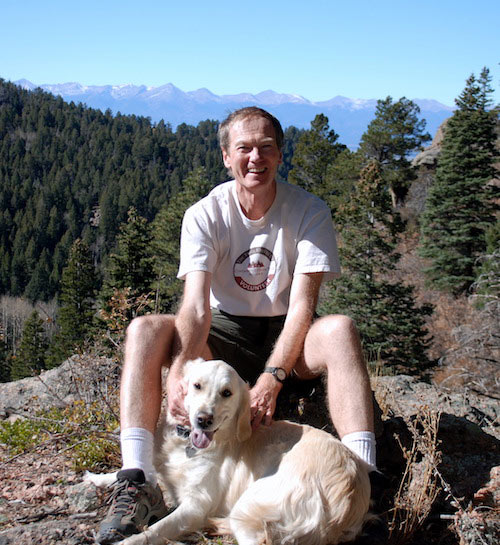I train a variety of clients who come from a pretty diverse range of ages and abilities. I’ve learned that no two clients are the same.
In this post I’ll go over how stretching can help with different exercises, and even make a few specific recommendations for stretches to use depending on your own sport of choice.
For example, let me tell you about the most cardiovascularly fit client I’ve ever worked with.
His name was Graeme, and he was 66 years old. A fun weekend for Graeme was something like two century bike rides… back-to-back. Or summiting multiple 14’ers in a day.

When I first met him, I was very impressed by his cardiac output… but then somewhat horrified by his posture!
Graeme is an accountant and a serious cyclist, so you can imagine just how badly he slumps. He had never thought about the long-term effects of both his job and his sport on his posture, joints or bone health. He was convinced that working on mobility, flexibility and strength would be a total bore… and maybe even a waste of time.
But he went from skeptic to loyalist till the day he dies (and I am never going to retire 😊). Once Graeme began implementing some simple strategies of corrective stretching and balancing out his body with corrective strength work – his entire posture and outlook changed – he even improved his time “climbing the incline,” which is a local mile-long vertical staircase here in Colorado Springs.
(You can read more of Graeme’s story here.)
Graeme was into cycling.
But what about other sports, like weight lifting? 🏋️♀️
People who are really into weightlifting, but who’ve never thought about long-term health or mobility, often come to me after they’ve had several accute injuries, hoping I can restore them “after the fact.” I often can help, but if they’ve left it too long, it takes time and effort, and sometimes too much damage has been done to the low spine, knees, hips or shoulders — to the point that medical intervention is necessary.
Regardless of the activity — whether it’s running, hiking, biking, weight training, or anything like these — different activities have their own sets of challenges when it comes to stiffness and chronic pain. They can leave the hips, low back, shoulders, knees and neck feeling worse sometimes rather than better.
So, do you need to stretch if you workout? Absolutely yes!
(In fact, one reason I created the Better Rest and Recovery Stretch Series was for precisely this demographic. People who are already active but who are starting to “feel it” a bit more than they used to. Recovery isn’t so easy. Some of those aches and pains take a bit longer to go away… The stretches in the Stretch Series booklet may look simple, but they are the cumulation of years of personal and professional experience.)
The good news for anyone is that if you are healthy now, or even if you’ve had a few incidents, or if you’re coming back from an injury and want to avoid another one in the future, by putting proper recovery strategies in place now you can stay in the game well into your later years.
But what if you’re in a time crunch?
Many people who are into sports have to struggle to make time for them. How do you add more exercises on top of that?
Well, one thing you can do is focus on the most important stretches for your particular sport.
Depending on your sport, some stretches might be more important than others.
Below, I’ve pulled a few of the stretches directly from the Better Rest and Recovery Series that will prove helpful for specific sports (and a few extras, when necessary). I’ve cut the stretches in half and paired them with specific activities to ensure you hit the most important areas to help you recover—all based on the demands of your specific sport of choice!
Sport- & Exercise-Specific Stretches
Hiking
Take 10 – 20 minutes out on the trail to sit quietly, reflect on the beauty around you, listen to the birds, the wind in the trees, the running water – whatever YOUR hike presents notice the beauty of it rather than just getting lost in your “to do” list
- Foam roll the mid back (link)
- Hip flexor stretch (link)
- Bent knee glute stretch (link)
- Spider stretch (link)
- Side lying thoracic rotation (link)
- Child’s pose QL stretch (link)
Cycling
Biking cadence can be a great way to meditate: focus on the peddle strokes, the sounds around you, and the wind on your face. Return to this over and over and allow the time on the bike to be restorative rather than just another grind
- Foam roll the hamstrings (link)
- Foam roll the mid back (link)
- Hip flexor stretch (link)
- Adductor / hamstring stretch (link)
- Side lying t-spine rotation stretch (link)
- Child’s pose QL stretch (link)
Running
As with cycling, running cadence can be a great way to meditate: focus on the foot strokes, the sounds around you, and the wind on your face. Return to this over and over and allow the time on the pavement or trail (dirt is always better on the joints) to be restorative rather than just another grind
- Foam roll the glutes (link)
- Foam roll the lateral hip (link)
- Bent knee glute stretch (link)
- Spider stretch with rotation (link)
- Child’s pose QL stretch (link)
- Lying banana stretch (link)
Weight Training
I cannot stress enough that weight training is NOT a time to beat up your body.
I teach weight training as well, and the nonsense idea that you didn’t get a good workout if you aren’t crawling out of the gym is just BS (not to mention actively harmful). Weight training should be done with proper intensity, yes, but pay attention to your body’s own signals for intra-workout recovery. Breathe. Have fun.
- Foam roll the mid back (link)
- Hip flexor stretch (link)
- Bent knee glute stretch (link)
- Side lying thoracic rotation (link)
- Child’s pose QL stretch (link)
- Parasympathetic breathing (min of 3 minutes) (link)
Taking care of our bodies
I have the great advantage of witnessing both what happens when you take care of your body, as well as what happens when you don’t take care of your body, as we age.
None of us can avoid aging, but we do have some control over HOW we age and the quality of life we live. My coach says, “Choose the behavior, choose the consequences.” How right he is.
We cannot control all disease or hardship. I know that all too well, but because of the healthy lifestyle I lead today and the choices I make daily to do the right thing (even when it’s the hard thing to do) I have been able to weather many great challenges in these 45 years, and I plan to weather many more with as much grace as possible.
This is one reason I am so passionate about sharing help like this with people like you. It is within your power to take control of your health, no matter how high the mountain might seem. Start where you are. Start with one stretch, one breath, one email to me. Whatever it is.
Today is the tomorrow you talked about yesterday.
Committed to your health,
Coach Rae
